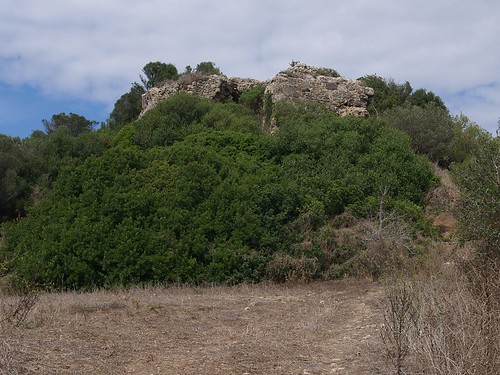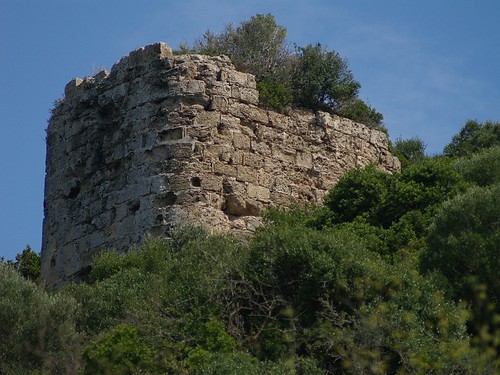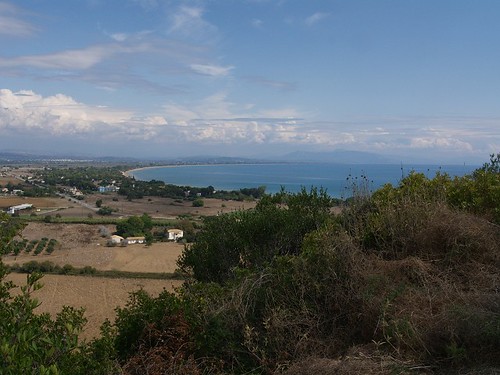sections
Remains of main gate, looking south

History/Description: Paradissis places the ancient city of Phea near here [206], a settlement dating back to 2,800 BC at least, and claims the site of Pondikokastro is that of the citadel of Phea (the remains of the town lie submerged in the sea nearby). He goes on to say that the current, Byzantine circuit follows the ancient one, and re-uses much of its masonry.
Pondikokastro as we now see it is a Byzantine fort [03:207; 04:114]. The masonry in the towers ('cloisonne masonry' - blocks of stone with tile shaped bricks inserted into the mortar between them) is typical of Byzantine work. The towers are an odd shape - square with rounded corners. In the main gate, the remains of an arcaded section of masonry with brick decoration reminds one of Androussa.
Villehardouin and Champlitte took it early in their conquest of the Morea, and it was known to the Franks as Beavoir, Beauregard, or Belvedere [03:207]. In 1217 the engagement of Geoffrey II Villehardouin to Iolande, daughter of the Latin Byzantine emperor was arranged here. In 1311 Isabella Villehardouin declared that this castle and Karytaina should be a dowry for her daughter, Margaret. Ferdinand of Majorca became master of the area in 1315, presumably of Pondikokastro as well. Munataner and the Catalans must have been here, since he praised the area for its beauty [03:207]. The Florentines and then Venetians held it, until in 1470 it was taken by the Ottomans and burned.
The whole site is badly overgrown, to the extent that it would be easy to fall over masonry or into cisterns. The views from the top are very good. Byzantine or Venetian commanders could, perhaps, have signalled to Kyparissia to the S, and perhaps other forts lying N. towards Patras, as well as inland.
'Mouse Castle' would seem an unusual name: Wright notes a charming story by a 17th century Moslem traveller Evliya-elebi:
'Inside this great city there was a magic charm in the shape of a golden mouse, fashioned by one of the ancient sages and placed on a high column. While the charm existed, there were no mice in the city, but at the time of the conquest, Muslim booty-hunters pulled down the column, tore off the golden mouse that was on it, and took it away. As soon as they did so, the entire city was taken over by mice, and not only could the people there not save their clothes and provisions, but the warrior's horses were all nibbled down into colts by the mice, which ate up their manes and tails, and all the weak old men, long in the tooth, had their hair, beards and mustaches eaten off and were turned into young lads by the mice.
Terrified by the mice, therefore, the entire populace abandoned the city and ran away, so that the whole place fell into ruin. There are still mice as big as cats in the orchards of the city but there is no trace of any of Adam's sons.' (Wright is quoting work by Pierre MacKay; see http://surprisedbytime.blogspot.com/2008/07/mouse-castle.html. As of 12 October 2008)
However, the name probably comes from the geography: the ridge on which the castle lies is divided into two unequal parts by a neck of land, with the castle on the head of the 'mouse' - rather like ears. It does look a little mouse-like from the land (the E), and I believe this impression may be gained from the W. side: one can imagine Byzantine sailors calling it 'mouse' as they coasted by.
Directions: the castle is set above Agios Andreas. Travelling towards Katakolo from Pirgos, there's a road on the right (about 2 Km before Katakolo). Follow this road along the foot of the ridge, around the N. end, and there is (or was in 2008) a cafe (Kastro Cafe) on the right. A lane opposite, on the left, leads steeply uphill, S. on to the ridge, where a footpath leads up on the left to a steep entry into the ruins. Or, you can get in the hard way by ascending through the olive groves N. of the castle. If you can reach the foot of the NE tower, its possible to inch around its base to the broken N. wall and scramble in that way. Once you're inside, mind the cistern on your left; I found no mice, but there was a large tortoise there.
Katakolo itself has a rail shuttle service from Pirgos, and is heavily oriented towards serving tourists from the cruise ships which frequently call there.
N.W tower, detail of masonry

View S. towards Kyparissia, which lies at the foot of the distant mountain

back to homepage
These pages created and maintained by Andrew Sawyer. Last updated September 2009